Archive for the “Spin-In” Category
It’s funny how you plan things, and then you somehow get taken in a completely different direction. I had thought to spend quite a bit of time practicing and playing with loop, coil, boucle etc. yarns, but then I bought a pair of fine cloth carders at P&M and suddenly I just wanted to blend everything in sight!
We did do a bit of fancy plying - some curly Wensleydale and knot yarns, I’m not sure what happened to the samples though. Maybe they’re under the sofa at Sarah’s still… In any case, we still had a lot of fun, and looking over the samples, we did do quite a bit - I hope you find them interesting!
Some of these are mine, and some are Sarah’s. She tied hers neatly into butterflies so it’s easy to tell the difference. We spun and plied them mostly on spindles, it’s definitely my favourite way of producing a bunch of samples in a short time.
Merino colour blends:

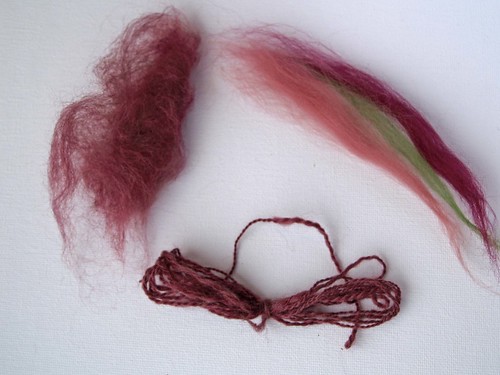

We were working on an idea here about achieving depth of colour with the blends. Abby’s tutorial on tweed yarns a while back got me thinking about the effects you get when you combine various colours. We followed a kind-of formula here by mixing complementary colours and then adding a teeny bit of a contrast for added depth.
Merino/Mohair blend:
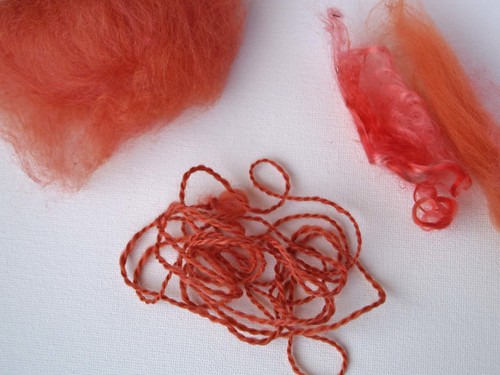
This is about 50/50 I think, although I didn’t measure it really. Once again, the difference in the colours adds depth to a yarn that a solid-dyed colour doesn’t have.
Mohair/Silk blend:

This is the same mohair blended with some dyed tussah silk, once again, about 50/50. It’s hard to tell from the photo, but the yarn turned out lovely! I’d really like to explore this blend further.
Alpaca/Bamboo (?) blend:
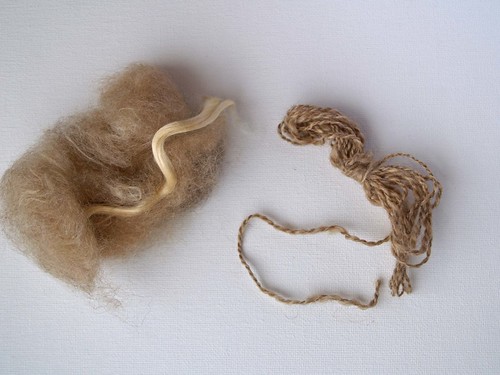
Not quite sure, this was one of Sarah’s. I’ll have to ask her about it. Yummy yarn though.
Combed Wensleydale:

Just for fun, I combed some locks that I had brought with me. It was fairly hard going, and a lot of waste, as the locks were a bit matted. But the resulting prepped fibre was a dream to spin and made a lovely lustrous yarn.
I’ll definitely be doing this again, maybe I’ll have a sampling party at my house one day :-)
 5 Comments » 5 Comments »
Today I’m up in Leicester with Yoshimi, and I came armed with piles of different fibres, and these:
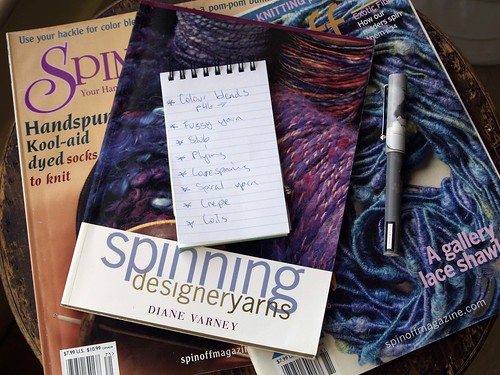
We’re planning to work our way through Diane Varney’s book, which contains loads of interesting stuff. I hesitate to say ‘novelty yarns’ because I don’t want to conjure up visions of fun fur and sparkly acrylic. Rather, think loop yarns, core-spinning, boucle, beads, (on-purpose) slub effects and blending. I’m bringing along the Spin-Off too as I’ve wanted to try that wrap-and-roll yarn for ages.
I’m not sure how many we’ll achieve, but I do know it’s going to be a lot of fun! Maybe the yarns will become more interesting as the beer and pringles run out…
So what are you spinning today? Have you ever spun (or wanted to spin) a novelty yarn? Why not spend ten minutes today sampling something you’ve never tried before :-)
I’m getting a train back tonight, but not sure what time, so you might see me on Lingr if I get in early enough. If not, feel free to talk amongst yourselves!
Ciao!
 3 Comments » 3 Comments »
 Posted by: Diane in Spin-In
Posted by: Diane in Spin-In
I’m dashing out the door in twenty minutes, so for today’s Spin-In I’m recycling my answer to a question I asked earlier in the week. Hope you don’t mind!
Q: Why is my skein underplied now, when before I washed it it looked balanced, or maybe a little z-twisty?
Plied yarns can be considered underplied, balanced, or overplied. In a balanced yarn there is a complementary amount of twist to that which was put into the singles, the plied yarn hangs in an open loop. Underplied yarn has less plying twist than spinning twist, and will hang with an s-twist (twists up like the letter s), overplied yarn will hang with a z-twist. There may be cases where you might want any one of these three - e.g. extra plying twist will help your yarn bounce and poof up, great for a woolly hat, but not what you want in a lace yarn though!
If you are plying your yarn fresh off from spinning it, you can check whether you are over/under/balanced by pulling some plied yarn off the wheel or spindle and letting it relax - does it twist up or hang open? But where you might run into difficulties is if your yarn hung nice and balanced when plied, but after washing was suddenly underplied. This is where we get into the complicated territory of singles that have been left to ‘set’ before plying.
Let’s say we put (a random number) a twist of ‘5’ into our singles when spinning. For a balanced yarn, we want to ply it back also with a twist of 5, or maybe 6 for a bit of bouncy overtwist. But the singles have been sitting on the bobbin for three days and even though they have a twist of 5, they look like they only have a twist of 3 now. If we ply with a twist of three, it will look balanced right up until it’s washed. Then all that twist will come back and our skein is underplied. Think of when you put your hair into braids. If you leave them in long enough, your hair will end up wavy, but this will disappear next time you wash your hair. Similarly with yarn, the original twist will come back when it’s wet - but we can’t wet our singles before we ply them.
You’ll almost always be plying yarn where at least one of the plies has been left to sit for a while, and you need to know what the original twist was. There’s two ways of dealing with it: If you’re of the organised persuasion, break off a length of yarn from your freshly spun bobbin/spindle and fold it back on itself, letting it twist up. This will show you the balanced twist of that yarn. You can leave that singles sit for a month if you like, just don’t lose the sample and you will know what your plied yarn needs to look like. The second way, for the absent-minded, is to break off that piece of yarn from the ‘set’ bobbin, fold it in half and knot the loose ends, then drop it in water. It will twist up in a very satisfying cool-to-watch way. And you have your balanced twist.
As you’re plying, ignore what the yarn is telling you - it will probably kink up like a maniac - and keep your little sample close by as a gauge. Once you wash the yarn, the twist will all balance out and you should have the correct amount.
Lastly, if you have a washed skein which you’re not happy with, simply wind into a ball and ‘ply’ it again, adding more twist or taking some out with the spindle or wheel until it’s where you want it. You can do this with any yarn that has too much or too little twist. You can even undo it completely and wind it back into singles - if you really wanted to…
—–
I’m out teaching today, and eating cake at Alice’s (yum!) but I’ll be back for Lingr between 6pm and 10pm tonight. Hope to see you there!
P.S. I haven’t forgotten the prize draw! The random-number-generator-hat just popped out two people for me, congratulations Carie and SylvChezPlum! I’ll email you tonight, or drop me a line if you see this :-D
 3 Comments » 3 Comments »
 Posted by: Diane in Spin-In
Posted by: Diane in Spin-In
There are two widely used methods for measuring spun yarn. One, the yards per pound measurement, is usually taken using a piece of equipment called a McMorran Balance. There’s a good article in the Summer 08 Spin-Off explaining this. A McMorran measurement, however, won’t really tell you how thick your yarn is - a heavy, drapey fingering weight may come up at the same ypp (yards per pound) as a light poofy DK, as the yarns each have the same amount of fibres, just spun in a very different way. Measuring the wraps per inch (wpi) will tell you the exact grist (thickness) of your yarn, although it won’t describe the density for you. Combining both measurements will give you the most complete picture.
Firstly, why would we even measure wraps per inch? Well, a few reasons. Taking notes of measurments such as grist, ratios spun and so on, gives you valuable information should you want to recreate the yarn at a later date. It may be that you want someone else to be able to recreate the yarn - e.g. in a published pattern. The more information you have, the better.
Measuring the wpi is also a good way to check a substitute yarn. Commercial yarns give a gauge on the ball band, but rather than knit swatches with all your handspun to find a match, you can simply measure the wpi of the commercial yarn, and those of your handspun skeins. Knowing the wpi can also give you a starting point for needle size - there’s a handy table in this article listing wpi and equivalent gauge.
So how is it done? Measuring wpi is quite simple really, however there are variables in play and it’s a good idea to practice a bit to make sure you are consistent. Instructions such as ‘wrap evenly and not too tightly’ are actually quite subjective, you may wrap ‘not too tightly’ with different judgement to someone else. If you know that you are always consistent yourself, then that is a good starting point.
Specially made wpi tools like this one are handy, but not essential. You can wrap your yarn around anything with measurements marked on it - or even a piece of dowel with tape markers. Wrap slowly and evenly, placing each layer next to the last without squashing them. This is much easier with smooth, drapey yarn than soft and puffy!
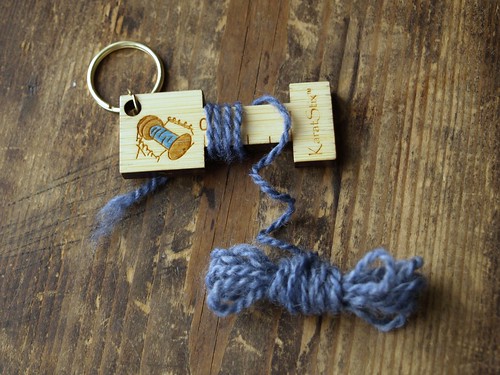
Continue until your inch is full - don’t be tempted to stop at half an inch as your reading may be inaccurate. Check that the yarn is not too tight or too loose, the threads should be touching, but not squashed. This yarn measures 12 wpi.
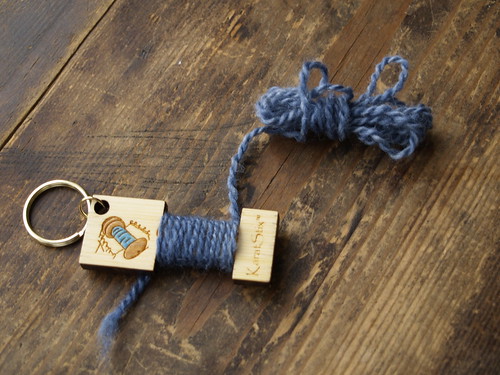
And that’s all there is to it! Practice measuring your yarn - find some commercial yarn you think looks the same as your handspun then measure them both to see how close you were. Measure different parts of your skein to check whether it’s even. Measure everything in sight until someone gets tired of you and takes away your ruler :-)

I have two little wpi tools to give away this week - leave me a comment telling me what you’re spinning today and on Thursday morning I’ll draw some names out of the proverbial hat. Good luck!
Don’t forget, we’re now on Lingr. Pop by today for a chat :-)

 31 Comments » 31 Comments »
 Posted by: Diane in Spin-In
Posted by: Diane in Spin-In
I had a query this week regarding fulling yarn, and more specifically, whether Navajo-plied yarn could be fulled. I thought I’d go into the topic in some more detail here.
As you probably know, fulling (or felting if your fibre is just fibre) happens under a number of different conditions in greater or lesser degree. Temperature stress (e.g. rapidly altered hot/cold conditions), friction, agititaion and moisture all contribute to the permanent tangling of fibres which we call felting. You don’t need all of these conditions to create felt or full yarn, but two or more makes the act go faster.
So how does this apply to our yarn? Imagine you’re spinning for a project you intend to full, or alternatively, something you hope will wear really well and hold up under such conditions of stress outlined above.
Fibre content is naturally important. Two things which contribute largely to feltability are fineness and scale structure. Therefore, a fine wool, which has overlapping scales which will open and close with temperature changes and lock together under friction, will felt very easily. A coarse wool will still felt, but will take more effort. Fibres with very smooth scale structure, like mohair, or no scales to speak of like silk or superwash fibre, will be much harder to felt (although not impossible, especially fine fibres, so be wary in washing!).
Let’s say you’ve chosen your fibre. Knitter A, making the felted bag, has chosen merino, Knitter B, who wants her cardigan to stand up well to wear, has chosen a Blue Faced Leicester/Mohair blend. Think about the conditions required for felting - what techniques of spinning and plying are going to affect the success of these yarns?
Knitter A needs maximum tangleability. She doesn’t want to have to put the bag through endless cycles in the washing machine to finally achieve a result, one cycle would be great since she’s in a hurry and needs to get this bag done and dry for the birthday party she’s going to tomorrow (she’s deluded - felt dries slowly and it’s raining, but she has a hair-dryer).
For maximum tangle the fibres in Knitter A’s yarn need room to move. Therefore spinning a lofty, woollen, low-twist yarn is the key here. With plenty of air in the yarn, the fibres have space. They can move across each other and the scales can open and close, locking together. Low-twist plying and finally a large needle size - leaving more air and room between the stitches - will finish the job.
Knitter B used a soft airy yarn for her last sweater and it felted under the arms the first time she wore it. She’s a bit more cluey now and this time she’s going to use a firm, worsted-style drafting technique and create a smooth 3-ply yarn. She’s also going to add a bit of extra twist when she plies and then treat the yarn rather roughly in the finishing process. This will do two things - it will take that extra plying twist and turn it into bounce, and it will encourage a little bit of shrinkage, making it less likely for the yarn to shrink later after it’s knitted. Knitter B also chooses a needle size which will give her a nice firm, but not stiff, gauge.
So what’s the answer to our original question? Can Navajo-plied yarn be fulled? The answer of course is, it depends. Is the single spun worsted or woollen? Is it lofty and undertwisted, or a tight firm twist? Have you knitted it at a big loose gauge or a firm gauge? As you can see, Navajo-plying by itself really doesn’t have much impact on feltability.
Practical exercise: (You can tell me later whether you want me to include these!)
Choose a fibre that will felt, e.g. merino, and spin a bunch of little samples. Try a singles yarn, a woollen 2-ply, a worsted tight-spun 3-ply, a soft 3-ply… whatever takes your fancy. Knit swatches at different needle sizes and label them with loops of coloured yarn, throw them all in the washer for one cycle. What do you observe? Shrinkage should vary a lot, even though the same fibre was used for each sample.
Do you have questions? Stories about shrinkage? Just want some company today in the rain? Come visit the spin|knit|design|write chatroom on Lingr.com, click the button below.

 3 Comments » 3 Comments »
According to my inner clock, Christmas is still a looooong way off. However, I have a little sneaking suspicion that it’s actually closer than I think, and therefore, I am going to make a list of Gifts I Plan to Make. Since Christmas is a long way off, I’m not actually going to cast on any yet, but it’s best to be prepared well in advance don’t you think.
Also, there’s every possibility that the List (previously only nebulously inside my head) may turn out to be longer than I suspected…
So:
2 pairs handknit socks
1 handspun scarf (I have half the yarn done for this btw)
2 skeins handspun laceweight
4 skeins handspun sock
1 beaded lace Swallowtail.
See - It’s really not that long is it. And I have all the yarn except the other half of the scarf. And the stuff I haven’t spun yet…
I will keep you posted on the progress.
- - - - -
In other news, I am very happy to announce the return of the Sunday Spin-Along!
It will consist of a slightly different setup, and I’m re-christening it as you can see below. There will no longer be photo requirements, although if I do see a picture and I’m truly impressed by it I may send you a little something :-D The pdf format will also be scrapped, making it easier to publish, and therefore hopefully more frequent.
I am hoping to post Spin-Ins every week, with some gaps maybe if I happen to be away. Think of them as snippets, gossip, hints, tips that I’ve picked up or worked out and am keen to share. After all, the more I put the knowledge out there, the faster I can take over the world convert new spinners! Mark Sundays in your diary now as the time to catch up on news and maybe try a new technique - and comment along with all the other readers in stereo.

Save the button for your sidebar, and link it to the Spin-In category. See you Sundays!
 1 Comment » 1 Comment »
|














 Entries (RSS)
Entries (RSS)